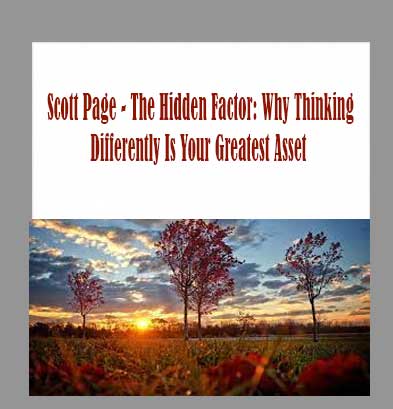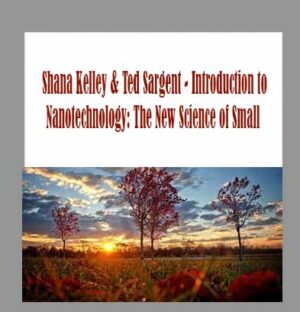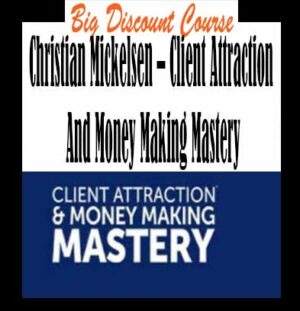Description
Scott Page – The Hidden Factor: Why Thinking Differently Is Your Greatest Asset download, Scott Page – The Hidden Factor: Why Thinking Differently Is Your Greatest Asset review, Scott Page – The Hidden Factor: Why Thinking Differently Is Your Greatest Asset free
Scott Page – The Hidden Factor: Why Thinking Differently Is Your Greatest Asset
The Hidden Factor: Why Thinking Differently Is Your Greatest Asset
Learn the strategies that make you a more diverse thinker and position you to break down institutional silos and build robust, effective teams, delivered by a pioneering researcher in his field.
LECTURE
Trailer
01:Individual Diversity and Collective Performance
In this opening lecture, Professor Page shares his intellectual excitement for the topic of diversity as he presents an outline for the course. Explanations of the importance of diversity, the types of diversity you will be covering, and the “big ideas†that motivate the course lay the groundwork for the discussion ahead….
30 min
02:Why Now? The Rise of Diversity
How do cognitive diversity and identity diversity differ? Where do they intersect? Investigate the key trends that have made diversity such a hot topic and understand why leveraging diversity of thought is necessary to meet today’s challenges….
30 min
03:Diversity Squared
What does the professor really mean when he says “diversityâ€? Examine the connotations commonly associated with the term and how the notion of diversity is changing. Further your understanding of the connection between cognitive and identity diversity as you begin your exploration of the “diversity bonus.â€â€¦
29 min
04:The Wisdom of Crowds
How can diverse ways of thinking contribute to a group’s ability to make accurate predictions? Walk through the diversity prediction theorem using clear examples-from guessing the weight of a steer to the height of the tallest building in Rio de Janeiro-to learn why the diversity and talent level of a crowd’s members play equal roles….
31 min
05:The Diversity Prediction Theorem Times Three
Now, turn to another application of forecasting: using knowledge of a population to more appropriately serve it. Analyze the case of the Netflix Prize-where teams competed to outperform the company’s movie-prediction model, Cinematch-to see how putting a diverse “ensemble†of ideas into action proved successful in the real world….
29 min
06:The Weighting Is the Hardest Part
Determining how much we listen to some people at the expense of others requires careful analysis. Learn strategies for assembling productive teams by zeroing in on the conditions that make assigning unequal weights to certain opinions and predictions desirable….
29 min
07:Foxes and Hedgehogs-Can I Be Diverse?
The course of your life depends on a handful of key decisions that are based on making predictions, from where you live to the career you choose. Compare the traits of the “fox,†who knows many things, and the “hedgehog,†who knows one big thing, to see how being a many-model thinker can impact your ability to make more accurate predictions….
28 min
08:Fermi’s Barbers-Estimating and Predicting
Hone your predictive skills with a discussion of four models: analogies, Fermi’s method or dimensional analysis, linear decomposition, and trend analysis. Learn which types of phenomena may be predicted-and which cannot-and why in this information age, we need to make estimations and predictions at all….
32 min
09:Problem Solving
As you turn your attention to problem solving, trace the ways it differs from prediction and how diverse heuristics-tricks, algorithms, and rules of thumb-can help devise better solutions. In this lecture, you’ll encounter a key insight of the course: A person’s contribution depends on individual talent and diversity relative to the team in equal measure….
29 min
10:Diverse Perspectives
Laser technology exists because Einstein saw light in a completely new way. Charge ahead with problem solving by exploring how a new perspective can bring order to complex questions. Analyze how diverse perspectives expand the set of the “adjacent possible,†and play a game of Sum to 15 to see how new perspectives can be transcendent….
30 min
11:Heuristics and the Adjacent Possible
Take your study of the “adjacent possible†to the next level by considering how diverse heuristics produce outside-the-box thinking and transcendent perspectives simplify difficult problems. Learn how individuals, organizations, and computers all use heuristics of varying levels of sophistication, and why computers may have an advantage….
31 min
12:Diversity Trumps Ability
A diverse group can outperform a team of the best talent, provided the problems are hard, the people differ, and the members have germane knowledge. Hear about the experiments that opened the professor’s eyes to diversity’s value in problem solving. Then, learn how the diversity prediction theorem illustrates how differences in perspectives and heuristics enable us to find better solutions….
27 min
13:Digging Holes and Splicing Genes
Delve more deeply into the diversity prediction theorem. Think about its implications for groups and individuals, and how it adds to your understanding of the paradigm-shifting trends related to changes in the nature of work, global demographics, and the proliferation of technology. Conclude with a look at models that inform decisions of hiring and college admissions….
30 min
14:Ability and Diversity
Can people be ranked in order of intelligence? Consider IQ tests in light of the course’s toolbox model of intelligence. Then, shift to a tree-of-knowledge-style model to think about with greater subtlety the connections between diversity and ability. Learn how to balance those elements and effectively structure teams for maximum output….
30 min
15:Combining and Recombining Heuristics
From the telegraph to the laser, a great deal of innovation stems from taking existing ideas, technologies, and tools and recombining them. Explore how ideas combine and recombine to drive economic growth. Then, probe how society can ensure continued innovation. Do we let people own ideas? Or do we set them free?…
28 min
16:Beware of False Prophets-No Free Lunch
In a rapidly changing, complex world, having a diverse set of tools is imperative. In this lecture, you’ll focus on formal and informal heuristics-procedures that try to improve performance-through a comparison of popular business and self-help books. Then, ponder opposite proverbs and the “no free lunch†theorem to comprehend the conditionality of heuristics….
30 min
17:Crowdsourcing and the Limits of Diversity
Big companies like Microsoft and Pfizer don’t necessarily make their problems and solutions public. Would they be better off if they did? Revisit the Netflix competition and look at other fascinating case studies as you weigh the benefits and limitations of crowdsourcing, the practice of offering up a problem to a population….
31 min
18:Experimentation, Variation, and Six Sigma
How do diversity and variation differ? Analyze how variation can make individual and system-level performance more robust by enabling faster adaptation. Conversely, learn about the six sigma movement toward anti-variation and when variation should be prevented through minimizing experimentation….
30 min
19:Diversity and Robustness
Before discussing how diversity contributes to system robustness, the professor takes a moment to reiterate the definition of robustness and the differences between variation and diversity. Analyze how portfolio effects, Ashby’s law of requisite variety, and redundancy and overlap support the case for diversity….
30 min
20:Inescapable Benefits of Diversity
Diverse ecologies, cities, and groups often outperform their homogeneous counterparts. Learn why this is often the case, then identify why additional contributions sometimes produce negative results or diminishing returns. Participate in a thought experiment involving diverse ecosystems to drive home the lesson….
34 min
21:The Historical Value of Diversity
See how the need for diversity has echoed throughout human history by evaluating how lack of cognitive difference leads to stagnation. You’ll weigh the literal implications of the business adage “adapt or die†through tales of collapsed civilizations, including the Easter Islanders, the Anasazi of the American Southwest, and the Mayans of Central America….
30 min
22:Homophily, Incentives, and Groupthink
Groups aren’t always productive. In this lecture, the professor cautions against the dangers of groupthink and defines four processes that explain why it occurs: conformity, drift, homophily, and common incentives. Learn strategies to avoid the phenomenon, both as an individual who wants to stand out from the crowd and as an organization….
31 min
23:The Problem of Diverse Preferences
Can disagreement be desirable? Through a more in-depth look at homophily-the propensity to associate with like-minded people-and Arrow’s impossibility theorem, see how preference diversity creates problems and why good outcomes are often conflated with comfort. Discern the key differences between fundamental disagreements vs. instrumental disagreements….
30 min
24:The Team. The Team. The Team.
What challenges should you take on? What should your objective function be? In this final lecture, you’ll understand the critical importance of teams sharing a common goal, as well as the case for embracing dissent. You’ll revisit preference diversity to pinpoint conditions in which it can hinder progress or help prevent collapse….
30 min
DETAILS
Overview
From technology to business, two (or more) heads often prove to be better than one-but only if those heads are cognitively diverse. Diverse perspectives are a powerful tool for maximizing productivity and enhancing collective performance. Now, in The Hidden Factor: Why Thinking Differently Is Your Greatest Asset, you can learn the strategies that make you a more diverse thinker and position you to break down institutional silos and build robust, effective teams. Delivered by Professor Scott E. Page of the University of Michigan-a pioneering researcher in his field-these 24 thought-provoking lectures are packed with case studies, cautionary tales, and formal mathematical methods that prove the case for cognitive difference.
About
Scott E. Page
Our identities can be a key driver of cognitive diversity on many tasks. Who we are directly influences our experiences and also correlates with the information and training we acquire.
Professor Scott E. Page received a B.A. in Mathematics from the University of Michigan and an M.A. in Mathematics from the University of Wisconsin–Madison. He then received his M.S. in Business and his Ph.D. in Managerial Economics and Decision Sciences from the Kellogg School of Management at Northwestern University. He completed his Ph.D. thesis under the guidance of Stan Reiter and Nobel laureate Roger Myerson. He has been a Professor of Economics at the California Institute of Technology and The University of Iowa and is currently Leonid Hurwicz Collegiate Professor of Complex Systems, Political Science, and Economics at the University of Michigan. At Michigan, he is also a Senior Research Scientist at the Institute for Social Research, a Senior Fellow in the Society of Fellows, and the Director of the Center for the Study of Complex Systems. In addition, Professor Page has been a long-time External Professor for the Santa Fe Institute, an interdisciplinary think tank devoted to the study of complexity. In 2011, he was elected to the American Academy of Arts and Sciences. Professor Page has won outstanding teaching assistant awards at the University of Wisconsin–Madison and Northwestern University, the Faculty Teaching Award at Caltech, and the Faculty Achievement Award for outstanding research, teaching, and service at the University of Michigan. Professor Page’s research interests span a wide range of disciplines. He has published more than 60 papers in a variety of fields, including economics, political science, computer science, physics, geography, public health, business, philosophy, and complexity. In addition, he has served on dissertation committees for students in more than 10 departments. In recent years, his core interest has been the various roles of diversity in complex adaptive systems, such as economies and ecosystems. He is the author of Diversity and Complexity; Complex Adaptive Systems: An Introduction to Computational Models of Social Life (with John H. Miller); and The Difference: How the Power of Diversity Creates Better Groups, Firms, Schools, and Societies . All three books were published by Princeton University Press. His most recent book, The Model Thinker: What You Need to Know to Make Data Work for You, provides a toolkit for people to be able to leverage data and information to their advantage. A popular speaker, Professor Page has appeared at the Aspen Ideas Festival and the World Economic Forum and before numerous corporate and nonprofit audiences around the world, including Google, Ford, Genentech, the International Monetary Fund, and the Association of American Medical Colleges. He has also recorded Understanding Complexity with The Great Courses. Professor Page lives with his wife and two sons in Ann Arbor, Michigan.
REVIEWS
mandal
One of the best courses out there
Forget online vs in person vs whatever, the intellectual content in this course is better than 99% of the undergraduate and graduate courses I took at Penn State, NYU, and Rutgers. Professor Page is one of my academic HEROES! This is a course I will go back to again and again for inspiration and learning.
chrisp228
Lost all credibility with Lecture 3
The equation showing diversity makes all the difference between individual guesses and the crowd average guess leaves out one important fact: randomness and the Bell Curve of responses. You can’t credit diversity with all the gains in the crowd average.







